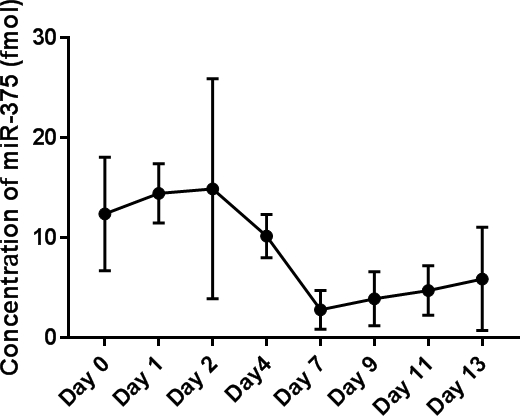Analysis of Human Islet Damage during In Vitro Culture Using miRNA 375
1Department of Surgery, School of Medicine, Virginia Commonwealth University, Richmond
2Hume-Lee Transplant Center, VCU Health System, Richmond.
Meeting: 2018 American Transplant Congress
Abstract number: B78
Keywords: Islets
Session Information
Session Name: Poster Session B: Islet Cell and Cell Transplantation
Session Type: Poster Session
Date: Sunday, June 3, 2018
Session Time: 6:00pm-7:00pm
 Presentation Time: 6:00pm-7:00pm
Presentation Time: 6:00pm-7:00pm
Location: Hall 4EF
Background
Islet culture prior to transplantation has been shown to facilitate recovery, reduce immunogenicity, suppress exocrine contamination and provides flexibility for evaluation of islets and preparation of patients. Moreover, optimal long-term islet culture techniques for research is much needed. Culture of islets has been inconsistent and it is shown that islets deteriorate rapidly in culture and lose their functional ability overtime. In this study, we evaluate the islet damage that occurs during culture. Previously, we have shown that miRNA-375 which is present in abundance in the beta cells can be potentially used as a damage marker both in vitro and clinically. Here we will evaluate the expression of miRNA-375 in the culture media during the two weeks culture period.
Methods
High purity islets were cultured on tissue culture flasks in Standard Prodo Islet Culture Medium. Islets were cultured at a target tissue density of 30,000IEQ per 30ml media. After 1, 2, 4, 7, 9, 11 and 13 days of in vitro culture, samples of the tissue culture supernatant were collected and snap frozen at -80[deg]C. Total miRNA extraction from 200[mu]L of supernatant was performed using miRCURY miRNA isolation kit. Complementary DNA strand synthesis was performed using miRCURY Universal cDNA synthesis kit. This was followed by quantitative PCR using SYBR green PCR master mix using locked nucleic acid–based miRNA primers. Conventional islet damage markers c-peptide and proinsulin was also measured using ELISA.
Results
Absolute quantification of miRNA-375 was evaluated by using the standard curve. These results indicate that miR-375 levels remained high up to day 2 suggesting ongoing post-isolation islet damage, followed by decrease in miR-375 levels up to day 7, which may infer recovery phase of islets. Then these were gradually increased again, indicating persistent islet damage.
Conclusion
In conclusion, miRNA 375 is a reliable marker for measuring islet damage in culture and may be helpful to develop optimal culture techniques.
CITATION INFORMATION: Shindo Y., Levy M., Kanak M. Analysis of Human Islet Damage during In Vitro Culture Using miRNA 375 Am J Transplant. 2017;17 (suppl 3).
To cite this abstract in AMA style:
Shindo Y, Levy M, Kanak M. Analysis of Human Islet Damage during In Vitro Culture Using miRNA 375 [abstract]. https://atcmeetingabstracts.com/abstract/analysis-of-human-islet-damage-during-in-vitro-culture-using-mirna-375/. Accessed December 9, 2025.« Back to 2018 American Transplant Congress
